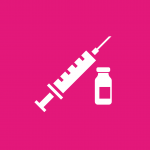Afterwards you may have moderate discomfort but this will only last around half an hour. You will be able to go home after around 15-30 minutes but will need someone to drive you. Any numbness will last for a few hours and these effects should resolve by the following day.
You will be given exercises to do, to maximise the effect of the steroid injection and increase any movement you have regained. Around 90% of people experience a reduction in pain and 70% benefit from increased movement. In some cases the improvement is immediate but for many people it can take a few weeks to take effect. You will be given an appointment to see a physiotherapist a few days after the procedure to see how well you are doing.
If you are diabetic you should carefully monitor your blood sugar levels for 48 hours after the procedure as blood sugar levels and insulin requirements may transiently fluctuate for several days.
Risks from the procedure are very small but in rare cases you may develop an infection. If your shoulder becomes swollen and painful or you develop a fever you should seek emergency treatment. If you have developed an infection you will be given antibiotics and the joint may need to be washed out. In rare cases people can be allergic to the steroid. This may cause a rash that can last upto a week. In rare cases people may have a severe allergic reaction to the iodine.
If the procedure is unsuccessful you may need to have keyhole surgery or manipulation under anaesthetic.





